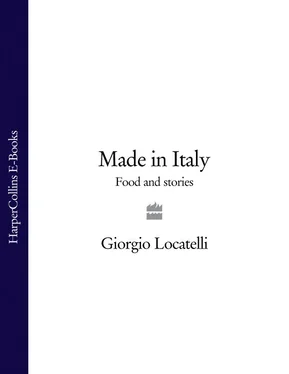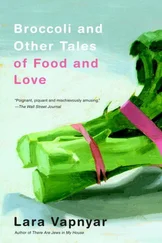I can never understand why people buy ready-made vinaigrette in a bottle when there can hardly be anything simpler than mixing together some good oil and vinegar, seasoning it with a little salt (I also add some water, just to soften the dressing), putting it into a bottle with a cork in it and storing it in the fridge. That’s it. My children make vinaigrette at home without even thinking about it. So how can commercial manufacturers tell us that what they put in a bottle is better? Some of them seem to have invented a machine that leaves the dressing in a state of permanent emulsion, which people think must be a good thing. But all you have to do to emulsify a dressing is shake your bottle of oil and vinegar.
There is, of course, no rule that says you must use olive oil for everything – not even in an Italian kitchen would we be that partisan. Sometimes we use other oils, including walnut and hazelnut, to give a different taste to a salad. Just think about your flavours before you add a very distinctive-tasting oil, so that your ingredients and your dressing complement each other and you have no violent clashes.
The reason this is called Giorgio’s vinaigrette is not that I am doing anything special – millions of people around the world make exactly the same thing. It just happened that when I was at Zafferano there was a young Algerian chef who could never remember which dressing was which, because we used several in our kitchen. We would shout to him, ‘Vinaigrette!’ and he would say, ‘What does it look like?’ Eventually he stuck a label on each bottle and he called this basic vinaigrette, with oil and vinegar, ‘Giorgio’s vinaigrette’ – so the name has stuck.
I like to mix the vinegar and oil in the ratio of one part to six, but the flavour of vinaigrette is a very subjective thing and everyone has their own ideas. Personally, I don’t like to use a strong Tuscan oil, nothing too peppery and strong for vinaigrette, and you might prefer to add more or less vinegar. It also depends on the quality of the vinegar and its alcohol level. Make up some vinaigrette, taste it and adjust it as you like. The important thing to remember is that if you try it neat, it will taste more powerful than when you mix it with a salad. So, either test it with some leaves, or do what I suggest to my chefs: take a little of the dressing on a spoon, put it into your mouth, then suck it in quickly – it should be sharp enough to make you cough slightly, but not so strong that it really catches in your throat.
Buy the best quality oil and vinegar you can afford, because you can’t put in flavour that isn’t already there. And make up a big bottle, so that you use it all the time. I would be a very happy man if every British family had a bottle of Giorgio’s homemade vinaigrette in the fridge.
Put the salt into a bowl, then add the vinegar and leave for a minute so the salt dissolves.
Whisk in the olive oil and the water until the vinaigrette emulsifies and thickens.
Pour into a bottle, seal and store in the fridge, where it will keep for up to 6 months. It will separate out again into oil and vinegar, so before you use it, just shake the bottle.
Makes about 375ml
½ teaspoon sea salt
3 tablespoons red wine vinegar
300ml extra-virgin olive oil
2 tablespoons water
Aspretto di zafferano Saffron vinaigrette
Makes about 750ml
500ml white wine
150ml white wine vinegar
1 level teaspoon saffron strands
1 tablespoon caster sugar
100ml extra-virgin olive oil
Put the white wine, vinegar and saffron into a pan over a low heat and bring to the boil. Simmer until reduced by three-quarters, then remove from the heat, stir in the sugar until dissolved and leave to cool. Whisk in the oil.
Store the vinaigrette in the fridge, where it will keep for up to 6 months in a screw-topped jar or bottle – or a squeezy plastic one. Take it out of the fridge half an hour or so before you need it, and shake to emulsify before use.
Condimento allo scalogno Shallot vinaigrette
Makes about 250ml
2 banana shallots or
4 ordinary shallots
75ml red wine vinegar
150ml extra-virgin olive oil
salt and pepper
Finely chop the shallots, then put them in a bowl and season with salt and pepper.
Add the vinegar and leave to stand for 30 minutes.
Whisk in the oil and use straight away.
Condimento all’aceto balsamico Balsamic vinaigrette
Makes about 350ml
1 teaspoon salt
250ml balsamic vinegar
100ml extra-virgin olive oil
Put the salt into a bowl, then add the vinegar and leave for a minute so the salt dissolves. Whisk the oil into the vinegar.
This will keep in the fridge for up to 6 months in a screw-topped jar or bottle – or a squeezy plastic one. Take it out of the fridge half an hour or so before you need it, and shake to emulsify before use.
Olio e limone Oil and lemon dressing
Makes about 200ml
pinch of salt
3 tablespoons lemon juice
150ml extra-virgin olive oil
Put the salt into a screw-topped bottle or jar, then add the lemon juice and leave for a minute so the salt dissolves.
Add the oil, put the top on, and shake well to emulsify. It is best to use this dressing immediately.
Makes about 600ml
1 egg yolk
pinch of salt
1 teaspoon English mustard
2 tablespoons white wine vinegar
500ml vegetable oil
juice of ½ lemon
Put the egg yolk in a mixing bowl and break it up a bit.
Add the salt and mustard with half of the vinegar and whisk together for a couple of minutes (this is very important as it helps the mayonnaise to emulsify once you start to put in the oil).
Slowly start to add the oil, whisking continuously, until it is completely incorporated. If it starts to get too thick, add the rest of the vinegar; and if is still too thick add a tablespoon of hot water – just enough to loosen.
When the oil is completely incorporated, add the lemon juice and adjust the seasoning to your taste – add a little more vinegar or lemon juice if you like it a little more sharp.


‘All about balance’
At home, when I cook something that Plaxy regularly makes, my kids often say my version tastes different – the reason, I think, is the seasoning. I was shocked the first time I saw chefs using salt in a restaurant kitchen because the proportions seemed enormous: handfuls were going into every pot, over meat, fish, vegetables. I remember going home to my grandmother and saying: ‘They use so much more salt than you.’
As a chef, you are taught to see salt in a different way. You have to think about how we taste our food; receiving different sensations in different parts of the mouth. If you under-season, you are taking away a whole layer of flavour; if you over-season, you block out all the other sensations. Salt can also help you experience sweet flavours in a more pronounced way. Heston Blumenthal of the Fat Duck in Bray does an experiment with a glass of tonic water – if you keep adding salt a little at a time, it gets to the point where it tastes sweeter; then obviously if you carry on, the saltiness takes over. At Locanda, we do a tomato ‘soup’ for a dessert with basil ice cream. When we first made it, we served it with sweet sablé biscuits, then we tried it with slightly salty biscuits, and the difference was amazing.
Читать дальше














